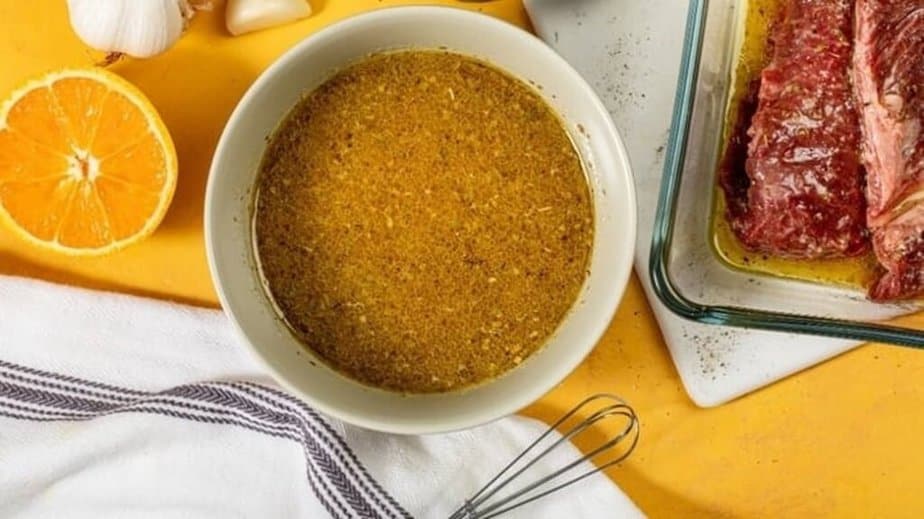Mojo seasoning is a marinade fondly used in Cuba, many parts of South America, and the Caribbean. This seasoning uses citrus juices as a base.
Today, mojo is an integral part of several Cuban recipes. Traditional Cuban dishes are spiced with readily available, inexpensive simple ingredients. Most dishes rely on few basic spices such as cumin, garlic, bay leaves, and oregano.
This article brings home to you the basic facts on mojo seasoning, its origin, uses, ingredients, flavor profile, and mojo marinade recipe.
What Is Mojo Seasoning?
The word “mojo’ literally means a magic spell, hex, or charm. In the world of cookery, mojo refers to several types of sauces with different levels of spiciness. In each region, you’ll find several versions of mojo seasoning with differences in ingredients and iterations. Generally, the primary constituents in the mojo mix are olive oil, local pepper varieties, paprika, garlic, cumin, and citrus juices.
Basically, it’s a marinade popularly used in the Canary Islands and Cuba and then spread to many parts of the Caribbean and South American countries.
Mojo seasoning has so many variations and it’s a good spice blend to add to your rack. You may make a customized version of this spice blend to suit your taste preferences. Actually, it’s said that in the Canary Islands, every family has their own unique recipe for this citrusy spicy mix.
Dry mojo seasoning contains ground dry spices, herbs, and dry peels of citrus fruits. Whereas freshly made mojo marinade is like a sauce wherein fresh lime and orange juices, and vegetable oil are used beside the other ground spices.
Origin of Mojo
In the past, the Canary Islands of Spain remained isolated from the rest of the world for years till the 20th century, and the local inhabitants gradually developed a flavorful spice mix to marinate their favorite dishes.
Mojo originated in the Canary Islands where the inhabitants simply used a blend of locally available spices and herbs to marinate seafood and meat dishes. Traditional Canary cuisines use two main varieties of mojo – red mojo (Mojo Rojo) and green mojo (Mojo Verde).
The main features of Canarian cuisine are its freshness, variety, and richness of ingredients.
How Does Mojo Seasoning Taste Like?
Widely used in the Caribbean and South American cuisines, mojo is a citrus-based marinade used with seafood, chicken, pork, or beef. It is the signature marinade of Cuba and it finds its way into several dishes in different cuisines across the world.
The taste of mojo is dominated by bold spices and zesty citrusy notes. The secret of tastes in many Cuban dishes is indebted to this seasoning. Mojo adds deliciously citrus notes and mild sweetness to the dish. Peppers used in mojo seasoning produce a lingering heat on your taste buds. Its earthy aroma and tangy flavor are a wonderful treat for your sensory pleasures of taste. In short, the mojo mix is slightly peppery, somewhat spicy, a bit tangy, yet sweet and citrusy.
Mojo Ingredients
Today, there are several variants of mojo mix with differences in a few ingredients and taste profiles. A traditional mojo seasoning includes garlic, cumin, black pepper, onion, oregano, olive oil, orange, and lemon juices.
Often, different combinations of citrusy juices are used in mojo mixes such as orange and lime, carambola and pineapple, or simply vinegar. One or two of the citrus juice is added to a mixture of herbs, onion, garlic, cumin, coriander, and red/black pepper.
Mojo Marinade
Mojo marinade, also known as mojito marinade, is very popular in Cuban cuisines, especially, to marinate seafood, beef, pork, and poultry dishes.
Different versions of mojo marinades are used according to the desired taste profile for each dish. In fact, you’ll find that almost every Cuban family has a specific mojo recipe that features its own unique spin on it. For example, some prefer to include oil but others may omit it. Usually, oil is omitted while marinating fattier meats like pork but oil is a nice addition to marinades used for lean poultry meat. Similarly, a few ingredients and proportions of constituents used in this mix also vary from recipe to recipe.
A typical fresh mojo marinade consists of:
- 1 cup fresh orange juice
- ½ cup fresh lemon juice
- ½ cup fresh oregano (coarsely chopped bits)
- 1/3 cup vegetable oil
- 10 minced garlic cloves
- 1 tablespoon ground pepper
Common Uses of Mojo Seasoning
Generally, mojo seasoning is used for marinating meat and seafood dishes. It’s often used as steak rub, or to season grilled seafood, grilled chicken, fried green plantains, or boiled yucca.
In Cuban cuisine, it’s the main ingredient in sofrito, a base ingredient for many traditional dishes. Dried and ground mojo is used for making different types of marinades and sauces.
Mojo, also known as “Spanish Barbecue Sauce“, is used for making Cuban mojo dip, sauce, or marinating fish, beef, pork, or chicken.
This salt-free Cuban spice mix is excellent for seasoning chicken or pork before roasting. Mojo mix is also used as a topical flavoring for meat, seafood, and vegetable dishes.
In the Southern region of the United States, restaurants serve a different version of mojo seasoning which includes additional ingredients like avocado and tomato; used as a spicy, tangy barbecue sauce with a hint of sweetness.
Related articles:
- What is a good adobo seasoning substitute?
- What to use instead of jerk seasoning?
- Best substitutes for taco seasoning.
